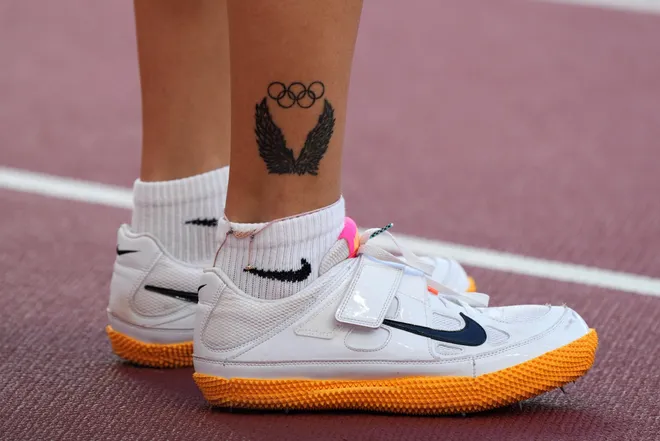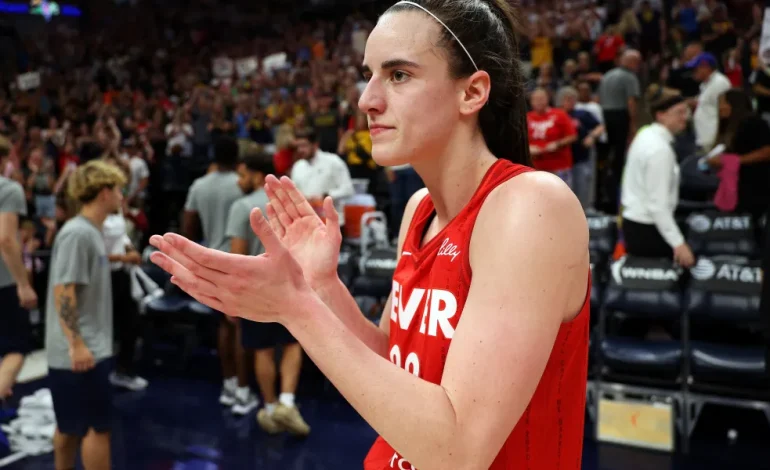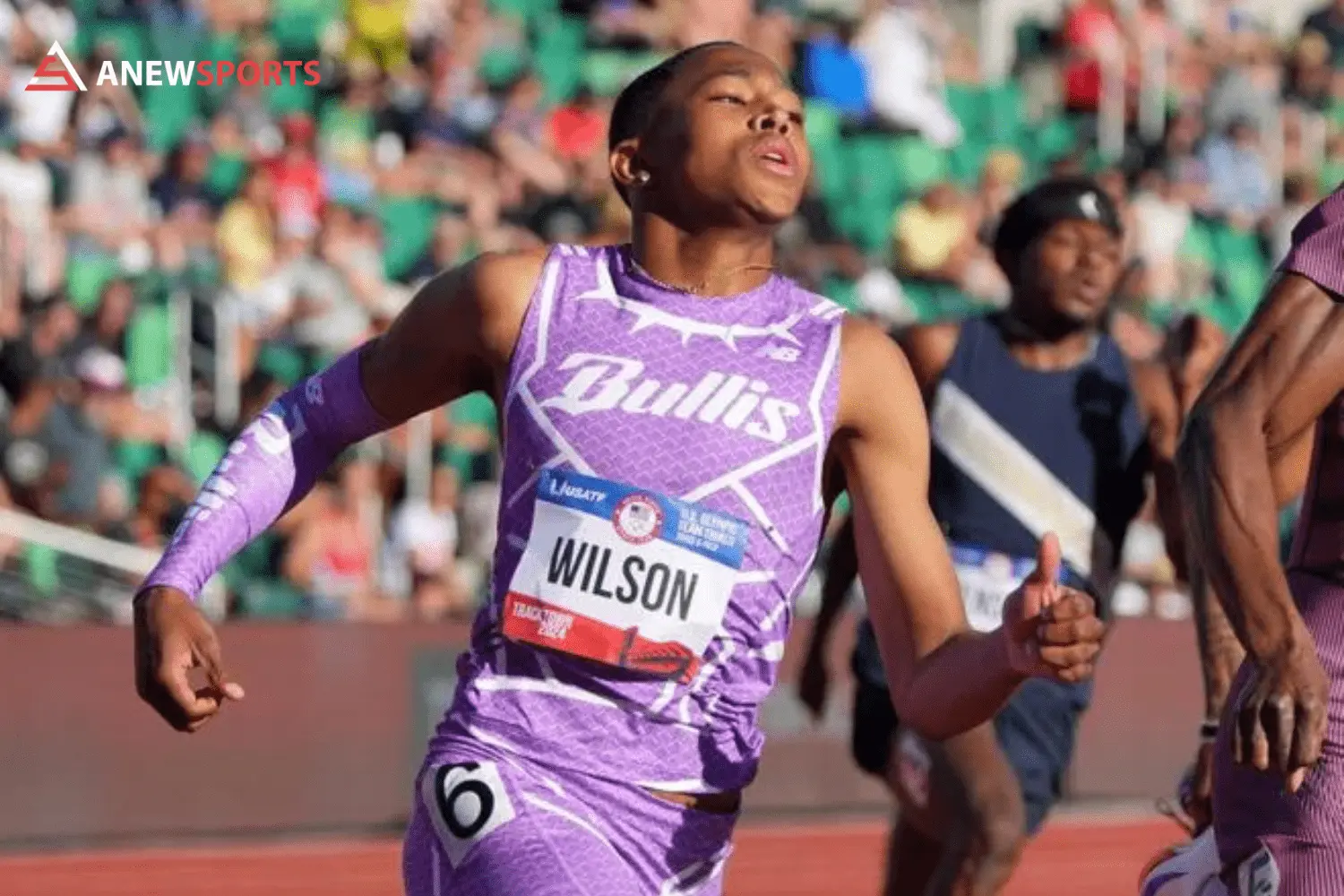
Inside the tradition of Olympic rings tattoos and why it’s an ‘exclusive club’
Nevin Harrison, who won a gold medal at the Olympics, got her first tattoo a month later. It cost $500. She thinks it was expensive, but she doesn’t regret it.
“I didn’t know what I was doing,” said Harrison. She won the women’s 200-meter canoe sprint at the Tokyo Games in 2021. “I just wanted the best one with perfect circles.”
Harrison said she got the Olympic rings tattooed on her wrist partly because many athletes in Tokyo had them. It’s a tradition among Olympic athletes that’s been around longer than Harrison, who is 22.
In the last 20 years, the rings tattoo has become common at the Summer Olympics. Athletes in many sports get them on their arms, necks, torsos, ankles, and feet. Some are large and colorful, easy to see on TV. Others are smaller and more subtle. But for most, the meaning is the same. It reminds them of the hard work they put into their sport and their success.
“I think it’s like a ceremony,” said Chris Jacobs, who won three medals in swimming at the 1988 Summer Olympics in Seoul. “It’s like a little card to a somewhat private club.”
Jacobs, who is now 59, started the trend more than 30 years ago. He noticed that some Canadian swimmers had tattoos of the Canadian flag. He decided to get the Olympic rings tattooed on his hip after the Seoul Olympics. It was low enough to be hidden under his swimsuit during competitions. A few years later, he got another one higher on his hip. Then, he got a bigger, colored version on his right bicep.
“They mean a lot to many people,” Jacobs said. “I wanted to remember that time in my life.”
Soon, stars like Michael Phelps and Ryan Lochte had the rings tattooed, too. The trend spread to other sports.
Gabby Thomas, an Olympic sprinter, said, “It reminds me of an amazing time in my life.”
Thomas got a black-and-white version of the rings tattooed on her neck after winning medals in Tokyo.
“It’s a great way to start a conversation,” Harrison said of her tattoo.
Evy Leibfarth, who started at the Tokyo Olympics at age 17, got the rings tattooed when she turned 18.
Kara Goucher, who first went to the Summer Games in 2008, waited 15 years to get her rings tattoo. She felt she didn’t perform well in her first Olympics.
Ben Hallock, who led the U.S. men’s water polo team in 2021, waited seven years. He wanted to think about why he wanted the tattoo and what it meant to him.
The tradition also moved to the Paralympics. But Paralympic athletes were told to cover the rings tattoo during competitions. The Paralympic logo is the Agitos, which look like check marks.
“I think it’s amazing how everyone makes their Olympic tattoos special,” said Casey Kaufhold, who has an arrow through the rings tattooed on her ankle.
There’s one rule: Superstition says an athlete should get the tattoo only after they compete in the Games.
Some athletes got the tattoo early and then got hurt or sick. Tucker knows of four athletes who missed the Olympics. She almost did the same thing but won a silver medal.

“You want to remember one of the best moments in your life,” Tucker said. “You want to remember what you did. And you want to be ready to do it again.”Nevin Harrison, who won a gold medal at the Olympics, got her first tattoo a month later. It cost $500. She thinks it was expensive, but she doesn’t regret it.
“I didn’t know what I was doing,” said Harrison. She won the women’s 200-meter canoe sprint at the Tokyo Games in 2021. “I just wanted the best one with perfect circles.”
Harrison said she got the Olympic rings tattooed on her wrist partly because many athletes in Tokyo had them. It’s a tradition among Olympic athletes that’s been around longer than Harrison, who is 22.
In the last 20 years, the rings tattoo has become common at the Summer Olympics. Athletes in many sports get them on their arms, necks, torsos, ankles, and feet. Some are large and colorful, easy to see on TV. Others are smaller and more subtle. But for most, the meaning is the same. It reminds them of the hard work they put into their sport and their success.
“I think it’s like a ceremony,” said Chris Jacobs, who won three medals in swimming at the 1988 Summer Olympics in Seoul. “It’s like a little card to a somewhat private club.”
Jacobs, who is now 59, started the trend more than 30 years ago. He noticed that some Canadian swimmers had tattoos of the Canadian flag. He decided to get the Olympic rings tattooed on his hip after the Seoul Olympics. It was low enough to be hidden under his swimsuit during competitions. A few years later, he got another one higher on his hip. Then, he got a bigger, colored version on his right bicep.
“They mean a lot to many people,” Jacobs said. “I wanted to remember that time in my life.”
Soon, stars like Michael Phelps and Ryan Lochte had the rings tattooed, too. The trend spread to other sports.
Gabby Thomas, an Olympic sprinter, said, “It reminds me of an amazing time in my life.”
Thomas got a black-and-white version of the rings tattooed on her neck after winning medals in Tokyo.
“It’s a great way to start a conversation,” Harrison said of her tattoo.
Evy Leibfarth, who started at the Tokyo Olympics at age 17, got the rings tattooed when she turned 18.
Kara Goucher, who first went to the Summer Games in 2008, waited 15 years to get her rings tattoo. She felt she didn’t perform well in her first Olympics.
Ben Hallock, who led the U.S. men’s water polo team in 2021, waited seven years. He wanted to think about why he wanted the tattoo and what it meant to him.
The tradition also moved to the Paralympics. But Paralympic athletes were told to cover the rings tattoo during competitions. The Paralympic logo is the Agitos, which look like check marks.
“I think it’s amazing how everyone makes their Olympic tattoos special,” said Casey Kaufhold, who has an arrow through the rings tattooed on her ankle.
There’s one rule: Superstition says an athlete should get the tattoo only after they compete in the Games.
Some athletes got the tattoo early and then got hurt or sick. Tucker knows of four athletes who missed the Olympics. She almost did the same thing but won a silver medal.
“You want to remember one of the best moments in your life,” Tucker said. “You want to remember what you did. And you want to be ready to do it again.”







